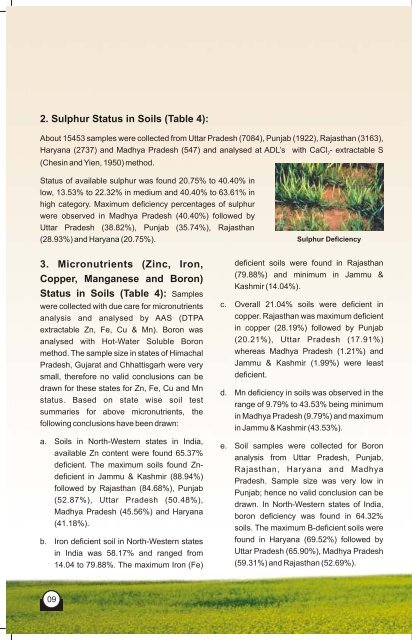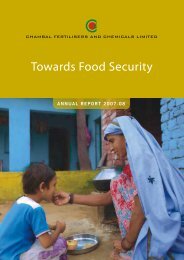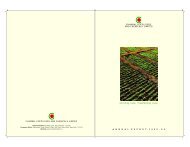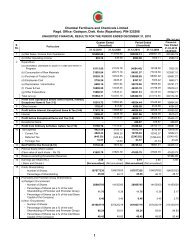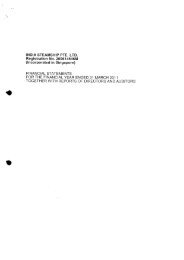Soil Fertility Status - Chambal Fertilisers - Home
Soil Fertility Status - Chambal Fertilisers - Home
Soil Fertility Status - Chambal Fertilisers - Home
Create successful ePaper yourself
Turn your PDF publications into a flip-book with our unique Google optimized e-Paper software.
2. Sulphur <strong>Status</strong> in <strong>Soil</strong>s (Table 4):<br />
About 15453 samples were collected from Uttar Pradesh (7084), Punjab (1922), Rajasthan (3163),<br />
Haryana (2737) and Madhya Pradesh (547) and analysed at ADL’s with CaCl2- extractable S<br />
(Chesin and Yien, 1950) method.<br />
<strong>Status</strong> of available sulphur was found 20.75% to 40.40% in<br />
low, 13.53% to 22.32% in medium and 40.40% to 63.61% in<br />
high category. Maximum deficiency percentages of sulphur<br />
were observed in Madhya Pradesh (40.40%) followed by<br />
Uttar Pradesh (38.82%), Punjab (35.74%), Rajasthan<br />
(28.93%) and Haryana (20.75%). Sulphur Deficiency<br />
3. Micronutrients (Zinc, Iron,<br />
Copper, Manganese and Boron)<br />
<strong>Status</strong> in <strong>Soil</strong>s (Table 4): Samples<br />
were collected with due care for micronutrients<br />
analysis and analysed by AAS (DTPA<br />
extractable Zn, Fe, Cu & Mn). Boron was<br />
analysed with Hot-Water Soluble Boron<br />
method. The sample size in states of Himachal<br />
Pradesh, Gujarat and Chhattisgarh were very<br />
small, therefore no valid conclusions can be<br />
drawn for these states for Zn, Fe, Cu and Mn<br />
status. Based on state wise soil test<br />
summaries for above micronutrients, the<br />
following conclusions have been drawn:<br />
a. <strong>Soil</strong>s in North-Western states in India,<br />
available Zn content were found 65.37%<br />
deficient. The maximum soils found Zndeficient<br />
in Jammu & Kashmir (88.94%)<br />
followed by Rajasthan (84.68%), Punjab<br />
(52.87%), Uttar Pradesh (50.48%),<br />
Madhya Pradesh (45.56%) and Haryana<br />
(41.18%).<br />
b. Iron deficient soil in North-Western states<br />
in India was 58.17% and ranged from<br />
14.04 to 79.88%. The maximum Iron (Fe)<br />
deficient soils were found in Rajasthan<br />
(79.88%) and minimum in Jammu &<br />
Kashmir (14.04%).<br />
c. Overall 21.04% soils were deficient in<br />
copper. Rajasthan was maximum deficient<br />
in copper (28.19%) followed by Punjab<br />
(20.21%), Uttar Pradesh (17.91%)<br />
whereas Madhya Pradesh (1.21%) and<br />
Jammu & Kashmir (1.99%) were least<br />
deficient.<br />
d. Mn deficiency in soils was observed in the<br />
range of 9.79% to 43.53% being minimum<br />
in Madhya Pradesh (9.79%) and maximum<br />
in Jammu & Kashmir (43.53%).<br />
e. <strong>Soil</strong> samples were collected for Boron<br />
analysis from Uttar Pradesh, Punjab,<br />
Rajasthan, Haryana and Madhya<br />
Pradesh. Sample size was very low in<br />
Punjab; hence no valid conclusion can be<br />
drawn. In North-Western states of India,<br />
boron deficiency was found in 64.32%<br />
soils. The maximum B-deficient soils were<br />
found in Haryana (69.52%) followed by<br />
Uttar Pradesh (65.90%), Madhya Pradesh<br />
(59.31%) and Rajasthan (52.69%).<br />
09


